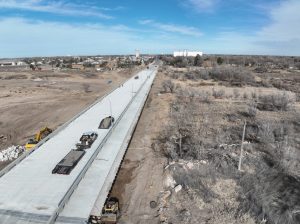Southwest Kansas highway project included in IKE Development Pipeline

Topeka, Kan.–Governor Laura Kelly on Thurssay announced a stretch of K-156 in Hodgeman County has been added to the IKE Development Pipeline.
This now clears the way for preliminary engineering work to begin on this $21 million regional project, according to the Kansas Department of Transportation.
Advocating for improvements to K-156 has been a mission for Lea Ann Seiler, former Economic Development Director for Hodgeman County and currently Southwest Regional Entrepreneurship Manager for NetWork Kansas.
“This expansion of Highway 156 from four miles west of Jetmore to the Finney County Line is incredible news,” Seiler said. “The increased safety and improved infrastructure will not only be a significant benefit for the farms and businesses that rely on this vital stretch of highway for their livelihood, but, more importantly, it will save lives.”
Another project selected for the IKE Development Pipeline expected to positively impact southwest Kansas is on U.S. 54 in Kingman County. A $173 million project to build a four-lane bypass from one mile west of K-11/U.S. 54 to the existing four lanes east of Kingman will help set up continued improvements to U.S. 54 to the west.
Governor Kelly and Kansas Transportation Secretary Calvin Reed announced the 2024 Development Pipeline projects in the Kansas Statehouse earlier today. The pipeline now includes 17 projects worth $932 million from across the state
.
“These highway projects tackle long-standing transportation needs across the state – improving safety, expanding economic development opportunities and strengthening our communities,” Governor Kelly said. “My administration is committed to making short- and long-term infrastructure improvements to benefit future generations of Kansans.”
Secretary Reed said input from Kansans helped determine what investments were of the highest priority to rural and urban communities. He said the selection process is flexible to meet economic needs and is based on engineering data, local consultation and geographic distribution.








